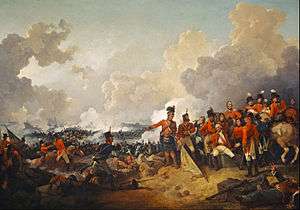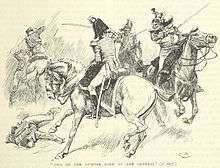Battle of Alexandria
| Battle of Alexandria | |||||||
|---|---|---|---|---|---|---|---|
| Part of French Revolutionary Wars | |||||||
 The Battle of Alexandria, 21 March 1801 Painting by Philip James de Loutherbourg | |||||||
| |||||||
| Belligerents | |||||||
|
|
| ||||||
| Commanders and leaders | |||||||
| Ralph Abercrombie (DOW) | Jacques-Francois Menou | ||||||
| Strength | |||||||
|
14,000 infantry 200 cavalry 46 cannons[1] |
8,330 infantry 1,380 cavalry 46 cannons | ||||||
| Casualties and losses | |||||||
| 2,300 wounded or missing [1] | 4,000+ dead, wounded or missing [1] | ||||||



The Battle of Alexandria or Battle of Canope, fought on 21 March 1801 between the French army under General Menou and the British expeditionary corps under Sir Ralph Abercrombie, took place near the ruins of Nicopolis, on the narrow spit of land between the sea and Lake Abukir, along which the British troops had advanced towards Alexandria after the actions of Abukir on 8 March and Mandora on 13 March.
Prelude
The British position on the night of 20 March extended across the isthmus, the right wing resting upon the ruins of Nicopolis and the sea, the left on the lake of Abukir and the Alexandria canal. The line faced generally south-west towards the city, the reserve division under Major-General Sir John Moore on the right, the Foot Guards brigade in the centre, and three other brigades on the left. In the second line were two infantry brigades and the cavalry (dismounted).
Battle
On 21 March, the troops were under arms at 3 a.m., and at 3:30 a.m. the French attacked and drove in the outposts. The French army now moved forward with great rapidity in their usual formation of columns. The brunt of the attack fell upon Moore's command, and in particular upon the 28th (North Gloucestershire) Regiment of Foot. The British repulsed the first shock but a French column penetrated in the dark between two British regiments. A confused fight ensued in the ruins, in which the 42nd Black Watch captured a colour. The front and rear ranks of the 28th were simultaneously engaged, whereby the soldiers received the order "Front rank stay as you are, rear rank about turn" and the conduct of the regiment won for it the distinction of wearing badges both at the front and at the back of their head-dress.[2]
Other regiments that assisted in the overthrow of the French column were the 23rd, 40th and 58th. In a second attack the enemy's cavalry inflicted severe losses on the 42nd. Sir Ralph Abercromby was here engaged in personal conflict with some French dragoons, and about this time received a mortal wound, though he remained on the field and in command to the end. The attack on the centre was repulsed by the cool and steady fire of the Guards, and the left wing maintained its position with ease, but the French cavalry for the second time came to close quarters with the reserve.
About half-past eight the combat began to wane, and the last shots were fired at ten. The real attack had been pressed home on the British right, and the History of the Queen's Royal West Surrey Regiment gives no undue praise to the regiments of the reserve in saying that "the determined attack would have been successful against almost any other troops." Technically, the details of the action show that, while not markedly better in a melee than the war-seasoned French, the British infantry had in its volleys a power that no other troops then existing possessed, and it was these volleys that decided the day even more than the individual stubbornness of the men.
The 42nd, twice charged by cavalry, had but 13 men wounded by the sabre. Part of the French losses were caused by the gunboats which lay close inshore and cannonaded the left flank of the French columns, and by a heavy naval gun which was placed in battery near the position of 28 March.
Aftermath
The forces engaged on this day were approximately 14,000 British to about 9,000 French. Losses for the British were, 1,468 killed, wounded and missing, including Abercromby (who died on 28 March), Moore and three other generals wounded. The French on the other hand had 1,160 killed and (?) 3,000 wounded.
The British advanced upon Alexandria and laid siege to it. The French garrison surrendered on 2 September 1801.
See also
References
- 1 2 3 Hawks, Francis Lister (1865). Appletons' Cyclopædia of Biography: Embracing a Series of Original Memoirs of the Most Distinguished Persons of all Times. D. Appleton & Company. p. 5.
- ↑ "Battle of Alexandria". Soldiers of Gloucestershire Museum. Retrieved 10 August 2010.
Coordinates: 31°18′38″N 30°04′06″E / 31.31056°N 30.06833°E